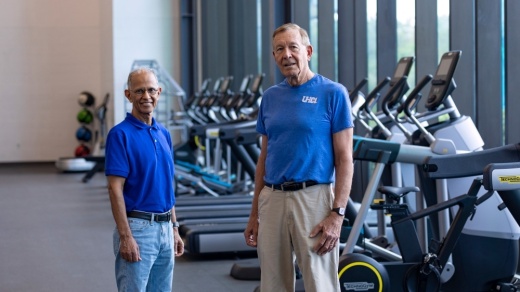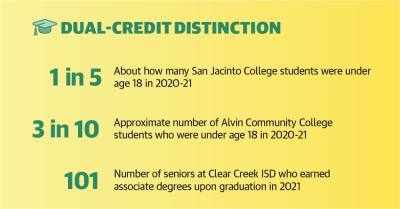Enrollment at San Jacinto College steadily increased from fall 2016 to fall 2019 before dipping last fall, and the portion of under-age-18 students out of the total student body grew about 9% from fall 2016 to fall 2020. Laurel Williamson, SJC’s president and deputy chancellor, said there is an increased desire for high school students to get a head start on taking college courses.
“I think that ... students in high schools want to get onto that college path more quickly,” she said.
Clear Creek ISD students have a chance to take SJC courses, particularly at Clear Horizons Early College High School. At this campus, students earn an associate degree as they earn their high school diploma; this comes at no cost to CCISD families through agreements with SJC and help families through agreements with SJC and help from the Clear Creek Education Foundation, per CCISD.
At the same time, some colleges are seeing more older learners seeking degrees, driven to shift careers during the coronavirus pandemic.
Jeff Schmitz said he felt a sense of relief the first time he saw Jabir Al-Hilali’s face on the screen in one of his University of Houston-Clear Lake classes, held over Zoom during COVID-19. The two 68-year-olds said they do not often encounter other students their age, so seeing each other the following semester at an in-person class was an even bigger relief, Schmitz recalled.
Per preliminary data, Schmitz and Al-Hilali are among about 240 students over age 50 on UHCL’s two campuses this fall, up from about 200 the year prior; students in this age range make up less than 5% of the respective campus populations. Older students represent one sector of nontraditional learners at area college campuses.
Student age is not the only change affecting classrooms and campuses, UHCL and SJC leaders said. COVID-19 has shifted the academic and emotional needs of students, and college officials said they are responding by allocating millions in federal funds directly to students. Younger learners
The definition of what makes a student nontraditional can vary and does not always include under-18 learners, but leaders at area colleges and ISDs said students are encouraged from younger ages to take on undergraduate coursework.
CCISD’s early college high school opened in 2007 to help low-income youth, first-generation college goers, English language learners, students of color and other underrepresented young people earn an associate degree along with their high school diploma. Students forgo their zoned high school, including the chance to participate in athletics there, and take four 90-minute classes per day at SJC’s south campus on Beamer Road to earn eight credits a semester.
A block of time is set aside at the beginning of each day for students to use support services, which Clear Horizons Principal Marshall Ponce said is a direct response to the unique needs of under-18 learners navigating undergraduate coursework.
Outside the classroom, Clear Horizons students take CCISD-sponsored group tours to area universities and complete internships. Student feedback has indicated the internships, in which students complete a project under the guidance of a self-selected mentor, are by far their most useful experience in college preparation, Ponce said.
“It’s very tailored to students’ needs, but it’s also framed by structures of support that help them to be successful,” she said of the educational experience.
Nearly 20% of SJC’s student population in fall 2020 was under 18. At the nearby Alvin Community College, nearly 1 in every 3 students were under 18 in fall 2020.
“We’ve seen even more of an increase in our dual-credit and high school enrollment,” Williamson said, adding these students often are high achievers. “In some ways, they outperform the more traditional students.”
As colleges adapt to shifting demographics, they also have had to adapt to the changing needs of students during the pandemic.
Requests for services have shifted at UHCL as students lose jobs or even homes, UHCL Associate Dean of Students Iliana Melendez said, adding there has been a significant increase in patronage of the on-campus food pantry. The college has expanded its available scholarships in response, she said.
“We’re just trying to make note of what [students’] needs are right now and shift how we support them in just a different world,” Melendez said. Nontraditional paths
The pandemic has spurred re-evaluation for many professionals with some deciding to switch or shift careers, Melendez said. This is the case for Schmitz and Al-Hilali, who are working toward master’s degrees in exercise and health sciences decades after achieving other graduate degrees.
Both said they look forward to taking more advantage of on-campus programming at the main campus on Bay Area Boulevard from biomechanics labs and exercise facilities to clubs, live theater and career-focused services.
The networking events UHCL hosts, however, are geared toward traditional students looking to find jobs—not community members such as Al-Hilali, who are hoping to build and promote their businesses or learn from a peer’s previous career experience, he said.
“It needs to be our kind of networking,” said Al-Hilali, who owns The Exercise Coach in Pearland.
Melendez defined nontraditional students at UHCL as those working full time; students over the age of 26; veterans, regardless of age; and, depending on their needs, students with physical disabilities. Many younger UHCL students who have families or work full time fall within the nontraditional lens, and many nontraditional students are also transfer students, she said.
The average age for full-time undergraduate students in the United States is 21.8 years old, according to national research database Education Data Initiative, and it rises to 27.2 years old for part-time undergraduates. UHCL’s and ACC’s full-time students have been on average between 23 and 25 years old in the last several academic years; San Jacinto’s overall average student age has remained at 23 since 2017. UHCL’s part-time students are older than the national average this fall at 29, per preliminary data. COVID-19 challenges, changes
Funding from the federal Higher Education Emergency Relief Funds was established through the Coronavirus Aid, Relief and Economic Security Act, signed into law in March 2020. This funding can be used for tuition; food; child care; housing; or health care, including mental health care, per the U.S. Department of Education.
SJC, UHCL and ACC have distributed, respectively, $39 million, $10.4 million and $6.5 million directly to students to date; each college also has several million dollars of the funds remaining to spend, either directly on students or for institutional support.
SJC officials created a new division within student services known as student support services, which launched this fall with the new division dean beginning her tenure, Williamson said. The division focuses on student activities, counseling and serving neurodiverse students, she said.
Local ISDs faced many challenges in terms of college preparation during COVID-19. At Clear Horizons, the challenges of remote education led some students to withdraw and return to their zoned school, Ponce said. There were times Clear Horizons was the only CCISD high school not holding in-person classes when CCISD returned in person before SJC did.
“We did lose students because they had trouble staying home,” she said. “We have to build back from that.”
This fall, SJC has seen an increase in students enrolled in developmental education courses, Williamson said. These courses are meant to help students brush up on the reading, writing and mathematics skills they need to be successful in all courses.
“The goal would be to not have any developmental education, ... and we had been approaching that goal pretty steadily until COVID,” Williamson said.







